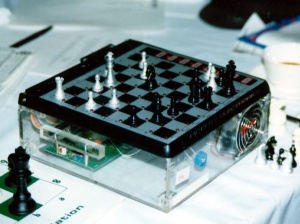Fidelity
Fidelity,
was a family of dedicated Chess Computers, manufactured by Sidney Samole's company Fidelity Electronics [2]. The early programs were written by Ron Nelson, since 1980/1981 most programs were based on Dan and Kathe Spracklen's Sargon programs. Fidelity chess computers with Spracklen programs, the commercial available Chess Challenger, Elite, Sensory, Elegance, Private Line and the experimental versions coined Fidelity X as covered on this page, participated in many tournaments with great success and won many world as well as national titles.
Contents
Fidelity X
1981-1984
Fidelity X, which won the WMCCC 1981, was later market as Fidelity Elite Champion [3] [4] . It was based on a 6502 Sargon program by Dan and Kathe Spracklen's. Same or slightly improved hardware played the ACM 1982, the WCCC 1983 and ACM 1984.
1986
In 1986, at the 17th ACM North American Computer Chess Championship in Dallas, Fidelity showed up with two experimental machines. Fidelity Experimental with Danny Kopec as Book author had one 68020 CPU, where three models also played the WMCCC 1986 some streets farther with compatible time schedule. Chess Challenger X was a parallel system with a Z80 controller, and 16 or more 68000 CPUs, co-authored by Ron Nelson, with a Kopec book as well.
Description 1989
Fidelity X, alias Fidelity/Motorola Challenger, which played the WCCC 1989 was a 32 bit program, targeting Motorola's 68030 processor [5]. Description from the WCCC booklet [6] :
The Fidelity/Motorola Challenger relies for its strength on a combination of state-of-the-art microcomputer hardware and a chess algorithm that has undergone continuous full-time development for over ten years.
The central feature of the hardware is a Motorola 68030 processor, hand-selected by Motorola engineers to run at the fastest possible clock speed. The exact speed will not be known until just prior to tournament time. The system is completed by 32K of program ROM, 64K of opening book ROM, 16K of program RAM, one megabyte of dynamic RAM for transposition tables, and a special 16K of non-volatile RAM that supports the learning feature.
The learning feature is just one facet of a multi-faceted chess algorithm. The program is basically brute force in origin with evolution to incorporate extensive positional analysis and selective extensions during the quiescence search. The positional analysis incorporates extensive heuristics for king safety and pawn structure. Numerous end-game specific routines are incorporated, icluding mate with bishop and knight, complete evaluation of king and pawn vs. king, probably outcome of a pawn race, square of the pawn, bishop and rook pawn of the opposite color, the Philidor and Lucena positions and others. Dynamic recognition of minimum mating material, fifty move rule, and repetition of position assist in forestalling heartbreaking draws in otherwise won positions. The search algorithm uses a depth first, alpha-beta search with the zero width window technique (PVS). The search proceeds iteratively with a quiescence search incorporating captures and certain threats appended beyond the nominal depth. The program will not perform an evaluation on a position where either king is in check. The check must first be resolved by showing the existence of an escape move or mate. Iterations are finally halted under the direction of a time control algorithm which is dynamically incorporated for up to 40 moves in the root position. Two killer moves are stored at every ply. The program performs a preliminary sort on the ply above the quiescence search. The search is supported by extensive transposition tables incorporating random numbers selected using BCH theory.
See also
- Book Issues in Cray Blitz - Fidelity X @ ACM 1984
- Fidelity Electronics
- Excalibur Electronics
- Hegener & Glaser
- Sidney Samole
- Sargon
- Dan Spracklen
- Kathe Spracklen
Fidelity Computers
- Chess Challenger
- Elegance
- Elite
- Excel
- Excellence
- Fidelity
- Fidelity Phantom
- Par Excellence
- Private Line
External Links
Chess Computers
Misc
References
- ↑ Fidelity X chess computer at the 6th World Chess Championship in Edmonton, Alberta, The Computer History Museum, Photo courtesy: Monty Newborn
- ↑ Fidelity Electronics from chesscomputers.org
- ↑ Fidelity Elite Champion Sensory Chess Challenger from Schachcomputer.info Wiki (German)
- ↑ Fidelity Elite Champion from Chess Computer UK by Mike Watters
- ↑ Fidelity
- ↑ Kings Move - Welcome to the 1989 AGT World Computer Chess Championship. Edmonton, Alberta, Canada, Courtesy of Peter Jennings, from The Computer History Museum, pdf
